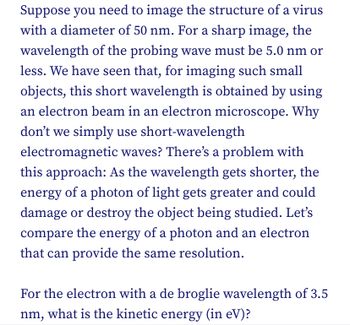Question

Transcribed Image Text:Suppose you need to image the structure of a virus
with a diameter of 50 nm. For a sharp image, the
wavelength of the probing wave must be 5.0 nm or
less. We have seen that, for imaging such small
objects, this short wavelength is obtained by using
an electron beam in an electron microscope. Why
don't we simply use short-wavelength
electromagnetic waves? There's a problem with
this approach: As the wavelength gets shorter, the
energy of a photon of light gets greater and could
damage or destroy the object being studied. Let's
compare the energy of a photon and an electron
that can provide the same resolution.
For the electron with a de broglie wavelength of 3.5
nm, what is the kinetic energy (in eV)?
Expert Solution
This question has been solved!
Explore an expertly crafted, step-by-step solution for a thorough understanding of key concepts.
This is a popular solution
Trending nowThis is a popular solution!
Step by stepSolved in 4 steps with 12 images

Knowledge Booster
Similar questions
- Violet light of wavelength 360 nm ejects electrons with a maximum kinetic energy of 0.89 eV from a certain metal. What is the work function of electrons to this metal, in electron volts?arrow_forwardElectrons with an energy of 0.842 eV are incident on a double slit in which the two slits are separated by 40.0 nm. What is the de Broglie wavelength (in nanometers!) of these electrons?arrow_forwardAn electron is accelerated from rest through a potential difference of 100 V. What is the de Broglie wavelength of the electron?arrow_forward
- An electron is accelerated from rest through a potential difference so that its de Broglie wavelength is 0.020 nm. What is the potential difference?arrow_forwardIn an experiment to study the photo-electric effect, light of wavelength 400 nm shining on a metallic surface causes electrons to be emitted. The maximum kinetic energy of the electrons is 1.05 eV (electron volts). Another light source of wavelength 200 nm is then tried, and the emitted electrons have a maximum kinetic energy of 4.20 eV. Using this information: a) determine the value of Planck's constant. b) determine the work function of the metal.arrow_forwardWhat is the wavelength of an electron of energy 2.0 keV ?arrow_forward
- a) Find the de Broglie wavelength of electrons moving with an average speed of 1.55 x 105 m/s. b) Suppose these electrons are described by a wave packet of width 2.55 nm. What is the uncertainty of the momentum of the electrons?arrow_forwardViolet light of wavelength 350 nm ejects electrons with a maximum kinetic energy of 0.87 eV from a certain metal. What is the work function of electrons to this metal, in electron volts ?arrow_forwardAn initially stationary electron is accelerated through a voltage 93.6 eV. What is it's de Broglie wavelength, in pm?arrow_forward
arrow_back_ios
arrow_forward_ios